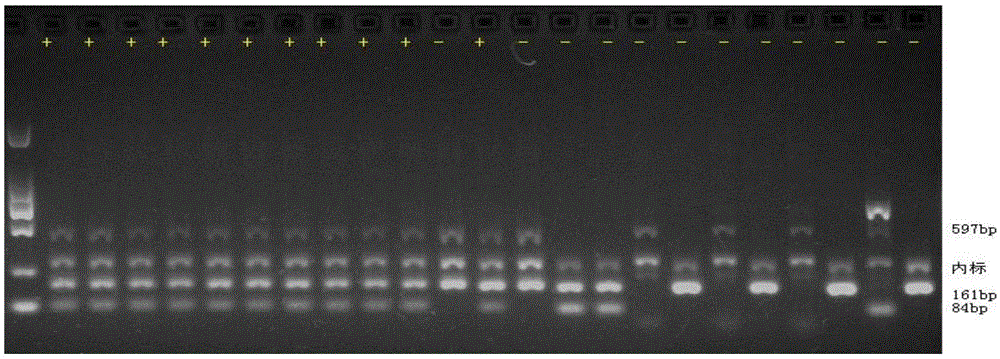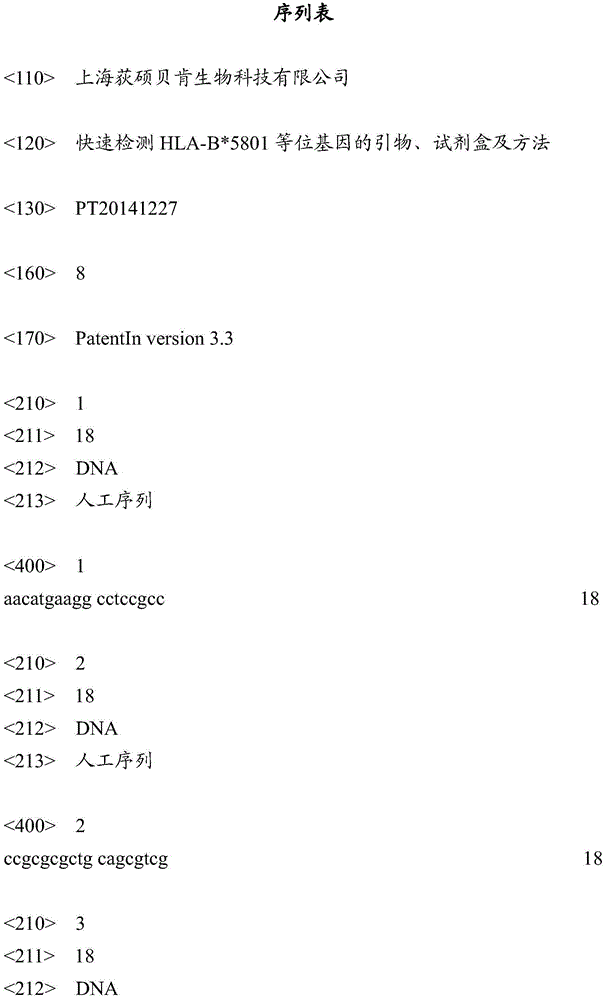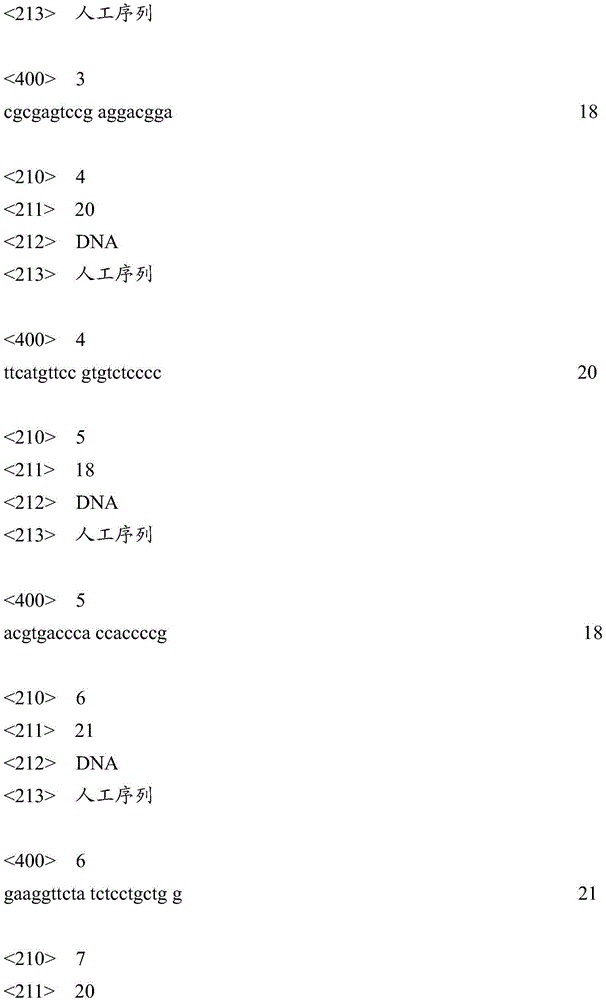Primer, kit and method for quickly detecting HLA-B*5801 allele
A HLA-B, 58PF01 technology, applied in the field of genetic engineering, can solve the problems of missed detection, inability to meet high specificity detection, incomplete genotypes, etc. Effect
- Summary
- Abstract
- Description
- Claims
- Application Information
AI Technical Summary
Problems solved by technology
Method used
Image
Examples
Embodiment 1
[0022] Example 1: Design of primers for rapid detection of HLA-B*5801 gene
[0023] The data of all HLA alleles required for PCR primer design comes from IMGT / HLA Database (Release3.15.0, 2014-01-17), the specific website is: http: / / www.ebi.nc.uk / ipd / imgt / hla / . The primers were designed manually, and the designed primers were compared in the IMGT database to confirm that the primers could specifically bind to the HLA-B*5801 allele. In the primer design process, the key is to make the designed primers specifically amplify the HLA-B*5801 gene in a specific PCR buffer system environment, that is, the primers are a kind of "sequence-specific SSP".
[0024] In order to screen the HLA-B*5801 gene using specific PCR-SSP, specific primers 58PF01 (SEQ ID NO.1) and 58PR01 (SEQ ID NO. ID NO.2), primer 58PF02 (SEQ ID NO.3), primer 58PR02 (SEQ ID NO.4), primer 58PF03 (SEQ ID NO.5) and 58PR03 (SEQ ID NO.6), 6 primers were used for multiplex Combining, merging into one specific reaction....
Embodiment 2
[0032] Example 2: Preparation of a kit for rapid detection of HLA-B*5801 gene
[0033] 1. Synthesis of primers
[0034] The primers were synthesized by Shanghai Yingjun Biotechnology Co., Ltd., and the sequences of the primers are respectively shown in SEQ ID NO.1-8, and the specific sequences are shown in Table 1.
[0035] 2. Preparation of PCR reaction mixture
[0036]Mix primers shown in SEQ ID NO.1-8, dNTPs, dye cresyl red, and Taq enzyme buffer. The concentration of detection primers SEQ ID NO.1-6 is 0.5 μM, the concentration of internal reference primers SEQ ID NO.6-7 is 0.2 μM, the concentration of dye cresyl red is 0.01%, and the concentration of dNTPs is 0.2 mM. The PCR buffer solution is: Tris-HCL at a concentration of 10 mM, potassium chloride at a concentration of 50 mM, magnesium chloride at a concentration of 1.5 mM, and gelatin at a concentration of 0.001%. The above-mentioned PCR reaction mixture and Taq enzyme are subpackaged and packaged to form a kit.
Embodiment 3
[0037] Example 3: Typing detection of HLA-B*5801 gene in samples
[0038] 23 DNA samples with known HLA-B site results were selected. Add to PCR tubes separately, and add Taq enzyme to each tube at the same time. After adding the sample, mix the reaction mixture evenly, centrifuge briefly, and carry out the PCR reaction.
[0039] The conditions of the PCR reaction are: 96°C for 2 minutes; then run 35 cycles in sequence according to the following procedures, 95°C for 30 sec, 60°C for 30 sec, and 72°C for 30 sec; finally, 72°C for 10 min, then cool down to 15°C for gel electrophoresis detection.
[0040] Use 0.5×TBE buffer to prepare 1.5% agarose gel. Take 3ul PCR products and directly spot on the gel well, electrophoresis for 20 minutes, and then take pictures and record under ultraviolet light. For specific gel electrophoresis pictures, see the attached figure 1 .
[0041] Interpretation of the results: When the internal control bands appear normally, there are two possibi...
PUM
 Login to View More
Login to View More Abstract
Description
Claims
Application Information
 Login to View More
Login to View More - R&D
- Intellectual Property
- Life Sciences
- Materials
- Tech Scout
- Unparalleled Data Quality
- Higher Quality Content
- 60% Fewer Hallucinations
Browse by: Latest US Patents, China's latest patents, Technical Efficacy Thesaurus, Application Domain, Technology Topic, Popular Technical Reports.
© 2025 PatSnap. All rights reserved.Legal|Privacy policy|Modern Slavery Act Transparency Statement|Sitemap|About US| Contact US: help@patsnap.com



